Abstract
The central theme of this report is to refute the idea of a wage gender gap. This issue has been actively reinforced by public sentiment and political reforms that are not grounded in knowledge of accurate statistics. The report provides valuable insights into the factors that contribute to the perceived gender gap: personality traits, working hours, career opportunities and education. Thus, the report shows that there are no actual differences in pay between genders.
Introduction
An in-depth study of current economic metrics and trends provides insight into the existing mechanisms and linkages inherent in today’s marketplace. The agenda dictates many of the rules and conditions that business enterprises seem to need to comply with to meet social demand. Nevertheless, it is essential to recognise that there may be a significant gap between the actual market situation and the public and politicians’ demands. Thus, the adoption of specific measures may prove disastrous for businesses and thus lead the market into a new socio-economic crisis.
Such reasoning is characteristic of research into the gender-specific characteristics of wages. It appears clear that the core of economic science is the perception of the fairness between the resources expended to do a job and the reward an individual receives for doing it. In the context of the issue at hand, it must be recognised that the gender of a worker who performs well should not affect the wage, as this would contradict principles of justice and equity. Nevertheless, socio-political demands dictate the urgent need to implement the Equal Pay Bill, which proposes a series of radical measures, including female quotas and deliberate increases in work rates, in response to the perceived gender wage gap. This economic report seeks to challenge this prejudice through an analysis of authoritative academic literature. Thus, the purpose of this report is to examine and describe in-depth statistical research and qualitative measurements to refute the idea of a gender gap in the wage context.
A Brief Explanation
In reality, there is an enormous variety of social mechanisms and levers that govern these judgements, but the most important is the historical background and active following of trends in modern society. The retrospective analysis clearly shows that, in most developed civilisations, women have long been unable to access paid work, providing care for the home and family, while men have been the sole source of income for the household. This idea has been historically embedded in the gene pool for generations, and although the modern world is in many ways much more progressive, such patterns are still present in the minds of consumers. In reality, women have long had access to jobs, and also, many of the career opportunities for women are even broader than those offered to men. Nevertheless, the deeply rooted idea of unfairly differentiated family responsibilities hurts contemporary society, prompting initiatives to address gender inequalities.
On the other hand, the public’s regular social demands to change the market structure to meet the perceived gender gap may be driven by a desire to follow trends. More specifically, in the current cross-section of societal patterns, there is a very marked trend towards the popularisation of views regarding women’s oppression, including in the context of economic justice. Consequently, it is reasonable to expect that many young people and adults, ignorant of the actual market agenda, broadcast ideas about the need to address the perceived gender gap without a deep understanding of these claims’ validity. Popular online posts, contemporary art materials and books continue to produce ripples of public morality whose directions are not relevant to the current economic situation. To convince readers of this report of the impossibility of a wage gender gap in the current reality, six significant economic works dealing with this issue are discussed below.
The Austrian Case
One of the key and, crucially, relevant works is the 2020 study examining the Austrian labour market. The choice of a particular region by a team of German and American university researchers was justified by the Wage Declaration Transparency Act of 2011 (Gulyas, Seitz, and Sinha, 2020). According to this reform, all large companies in the local market with a total annual income above an approved threshold must report their employees’ salaries. According to researchers, such an initiative makes it possible to monitor potential gender pay gaps and respond promptly if the analysis requires it. As an example of such a consolidated declaration, the paper cited the Australian Federal Government’s 2017 report, which ranked salaries according to the administrative board’s position (Figure 1).
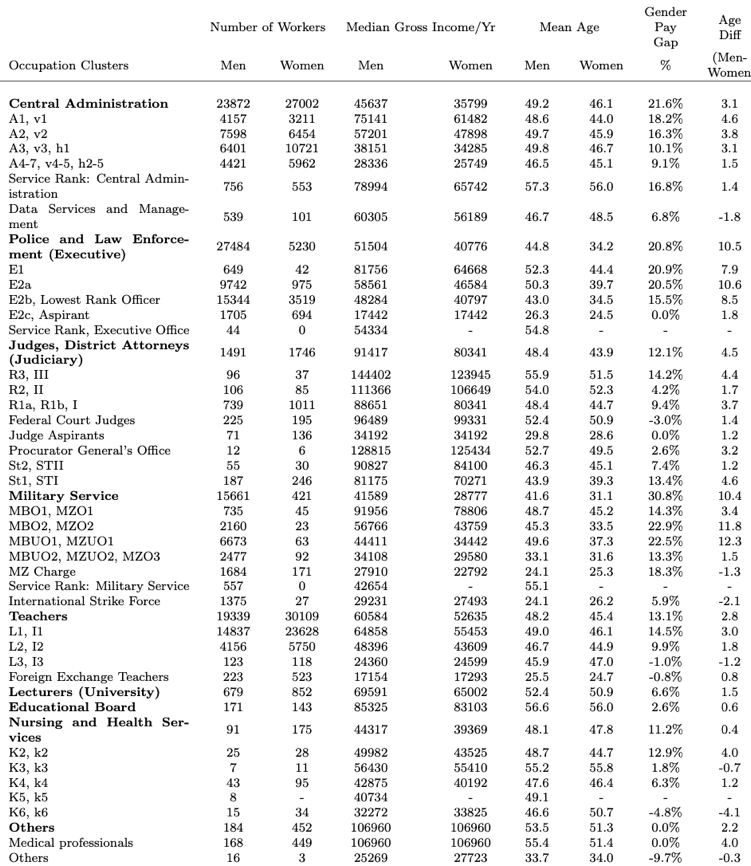
When analysing such data, the authors of this study paid particular attention to the methodology for processing the resulting statistics, as initially, even from Figure 1, it may seem that the gender gap is evident. Nevertheless, Gulyas, Seitz and Sinha found several logical justifications for this phenomenon, showing that the idea of a gap is untenable. First and foremost, employees’ salaries are directly related to the company’s financial policy, so focusing on just one of them is not a good strategy for critically evaluating the problem. The authors showed that 83 per cent of salaries are justified by an employee’s personal and professional characteristics but not by their gender (Figure 2). A second explanation for the seeming discrepancy is the fact that, on average, women are more likely to work in low-paying firms, which certainly affects the output statistics. Thus, using accurate data from several firms in the Austrian market, the authors of this study have concluded that the gender wage gap is virtually indistinguishable from zero and that the apparent discrepancies are justified by statistical errors.
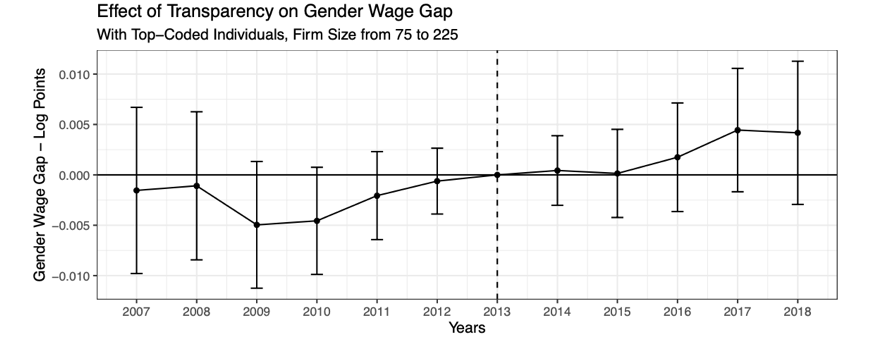
PayScale
In online publications, the belief that women earn on average 20 per cent less than the average man is often forced. PayScale, a primary U.S. agency responsible for developing software to analyse employee compensation and salaries, decided to examine this belief critically. It should be noted that PayScale is a highly respected company on the American market, with an extensive network of influence, significant investment proposals and representation not only in the U.S. business environment but also in other countries. Thus, it would be a mistake to doubt the published data’s integrity or bias, as PayScale has developed a compelling reputation as a reliable source.
As part of its annual reporting, PayScale released a paper covering the gender wage gap in 2020. The publisher had acknowledged the pay gap between men and women in studies conducted five years ago, but current data showed that the gap has narrowed to zero. In the control group test, which considers the representation of different influencing factors, women received $0.98 for every dollar earned by men, as shown in Figure 3. The definition of the control group implies an absolute identity of male and female characteristics, or to put it another way, gender neutrality and impersonality of employees.
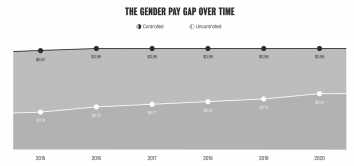
The marginal wage gap, as calculated by the agency, was not determined by the real gender gap but was characterised by several additional factors. In particular, women, on average, are slower to advance in their careers and, also, take up leadership positions later. This creates an opportunity gap, which puts pressure on the salary gap statistics. In other words, PayScale has numerically proven that the wage gap has historically been close to zero, and existing gaps can be justified by a number of side factors.
Heterogeneous Samples
A study released in 1999, debunking the myths surrounding discriminatory labour market policies, also takes a well-founded view that the gender gap is untenable. Notably, the seminal work was carried out by Furchtgott-Roth, an American who was Chief of Staff of the President’s Council of Economic Advisers. Thus, it is crucial to understand that Furchtgott-Roth had an important role in shaping U.S. economic policy and should not be biased. Consequently, her calculations and beliefs should be trusted.
The key arguments against the gender wage gap referred to in the scholarly work related to the failure of the statistics that activists use to promote discrimination. More specifically, the primary number, which is also found in most other works, identifies the 77 cents that the average woman earns for every $1 of a man’s wage. Furchtgott-Roth investigated the historical context of the gap and showed that this number has never been constant, and by 1820 it was 54 cents. According to the researcher’s logic, the very essence of the problem with such statistics was the deliberate averaging of women and men. In reality, women earn less than men, but the wage gap is not the reason for this difference. Instead, wages are influenced by overall seniority, education, company policies and employees’ personality traits. Generally, fields that require greater intellectual investment and are therefore better paid, such as physics or mathematics, have historically still had a higher proportion of male employees, which certainly affects the overall balance of salary statistics.
Nevertheless, similar factors do not determine the gender wage gap, as heterogeneous samples are initially considered. While all women in the world earn 77 cents per dollar of a man’s salary, sample refinement yields different results. For example, a comparison of childless men and women under 30 showed that the average wage for women was $1.08 per $1 for men. Even from this example, it is clear that the logic of the gender gap is untenable to the extent that it does not account for entirely homogeneous samples of women and men. To be more convincing, it should be noted that the calculations made for the year of publication of the paper, namely 1999, have been repeatedly checked and corrected, as Furchtgott-Roth is still actively involved in economic conferences and university lectures.
Dependent on a Variety of Factors
Many papers aiming to condemn perceived discrimination generally have little reference to accurate statistics and instead use general data. Similar thoughts are found in a 2002 report study in which the author assesses the mythical nature of the idea of a gender gap in the current market. In particular, Denise Venable (2020), who has a combined fifteen years of experience in project management and administrative process optimisation in the world’s largest companies, explored several grounds that may lead to an erroneous judgement. These included lifestyle, as women are more likely to turn to relationships and family without focusing on a career, part-time work and the age of entry into the labour market. Venable thus showed that the average pay difference between men and women could only appear critical because there was a differential approach to work. To support this, the author examined the average wage of women relative to men as a function of the number of hours worked per week (Figure 4). From this data, it can be seen that the size of the gender gap is directly related to women’s productivity, so there is no basis for claiming a severe gap.
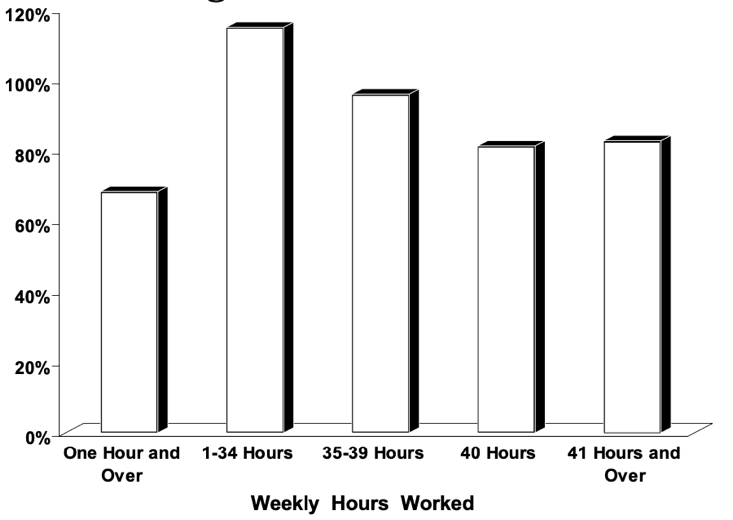
The influence of moral values
Intriguing data concerning the question under discussion is provided by Fortin’s (2005) study assessing the role of women’s and men’s moral attitudes and personality traits in relation to wages and expectations of employers. In particular, two one-questionnaires, NLS72 and NLS88, which measured the attitudes of a sample of people towards wages in different years, were the main instruments of the study. Fortin conducted in-depth statistical research into categories such as greed and altruism in an attempt to determine the drivers of worker productivity and hence the corresponding amount of wages received. Following the logic of the works cited, the author derived a mathematical relationship (equation 1) between the utility of work performed and the wage (W) of a genderless employee and his effort (R) and altruism (A). In addition, Fortin investigated the nature of the formulaic relationships previously identified by other researchers and showed through a series of deductions that their mathematical expressions did not make any real sense.
Ui = Ui (Wi, Ri, Ai) (1)
To clarify the current relationship between gender and wages, the author suggested using the concept of soft and hard skills. Thus, according to the study, higher salaries were not related to an employee’s actual gender but related to their personality traits, namely greed and altruism (Figure 5). Thus, the apparent gender gap concerning salaries was related to the unequal distribution of leadership qualities among employees, as was the more significant number of men in the enterprise than women. The NLS88 survey conducted 21 years after NLS72 showed that women had moved towards leadership in the name of aspirational qualities, so the apparent gap would have to be minimised and then probably tipped towards women.
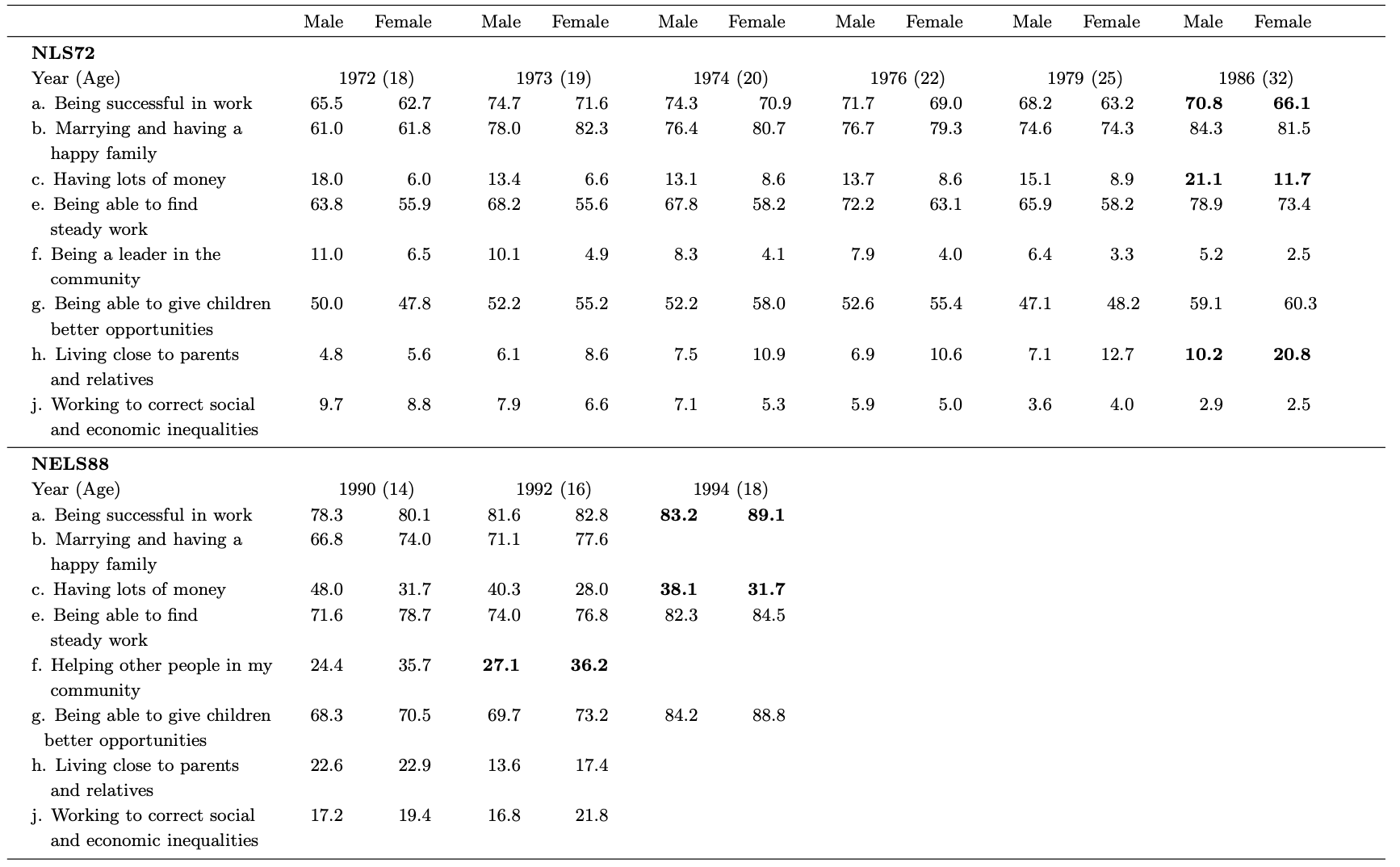
Variable and Fixed Pay
Interesting results about women’s and men’s attitudes toward risk-taking at work were obtained in a wide-ranging laboratory study designed to measure categories of employee productivity, performance and efficiency in response to a selected pay system. Specifically, Dohmen and Falk (2011) investigated the choice patterns between two pay systems: fixed-rate and variable-rate, which implies pay and performance matching. Thus, the second option meant that the more an employee worked, the more he or she was paid, and the measure of workload was not always working hours. An employee’s productivity and the number of tasks completed also explained the differences in pay.
One key finding showed that variable pay was less attractive to women, which was associated with a gendered approach to risk. Women seemed to be more afraid of taking personal responsibility for the plan than men, leading to commensurately lower wages. Moreover, it has been shown that jobs requiring more risk-taking tend to pay higher wages. Thus, it is clear that men earned more because they were willing to work harder and take more risks.

However, these facts do not determine the gender wage gap. The researchers proposed a multidimensional sorting apparatus that allowed them to determine that the gender gap is no more than a seeming consequence of several critical factors. Among them are differences in occupational choice — women are more likely to work in lower-paying, less risky jobs — career development, and work attitudes. The researchers have thus shown that there is no significant gender pay gap.
Conclusion
In conclusion, it is worth noting that the gender wage gap is a pressing issue for contemporary society. This trend may lead to harmful bills being introduced, ruining businesses. Nevertheless, the report has shown that authoritative academic sources and works do not support data on the qualitative wage gap and describe the seeming gap in predictors. Recognising the irrelevance of the gap to the market agenda will slow the lobbying for negative reforms and make it easier for businesses to do their jobs.
Search Strategy
Searching for research articles was difficult as most studies spoke superficially about the gender gap, repeating the same data. The strategy of searching and checking topical authoritative papers was done on Google Scholar for “there is no gender wage gap,” “gender wage equality,” and “gender wage gap”. For topical sources, author authority was checked on Google, and additional papers were examined to assess expertise. As the whole range of papers on the topic was of interest, filtering by year of publication was disabled.
Reference List
Dohmen, T. and Falk, A. (2011) ‘Performance pay and multidimensional sorting: productivity, preferences, and gender,’ American Economic Review, 101(2), pp. 556-90.
Fortin, N.M. (2006) Greed, altruism, and the gender wage gap. Web.
Furchtgott-Roth, D. (1999) ‘The myth of the wage gap,’ CRJ, 4(2), pp. 28-32.
Gulyas, A., Seitz, S. and Sinha, S. (2020) ‘Does pay transparency affect the gender wage gap? Evidence from Austria,’ CRC, 224(1), pp. 1-47.
PayScale (2020) The state of the gender pay gap. Web.
Venable, D. (2002) ‘The wage gap myth,’ National Center for Policy Analysis, 392(1), pp. 1-2.
